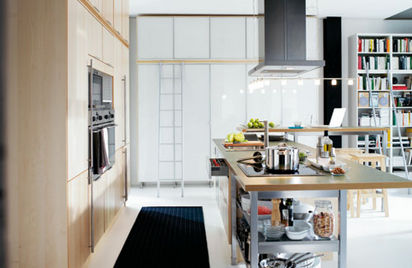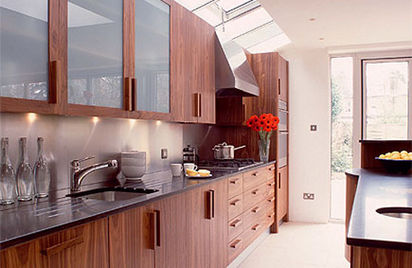Guide To Planning A Kitchen - at this point a lot of model homes, from minimalist to modern fancy, of course, when you search for home design model sesuakanlah the tastes and needs of your family, all right now on the blog Home Zone Design Guidelines we will discuss about Guide To Planning A Kitchen please read because we have Make a special update for you.
Could You Change The Current Layout?
If you're ripping out existing units, you don't have to stick to the previous layout, although if it's a small space you may be stuck with making the most of what you've got.
Where Should You Start?
As you go, think of a kitchen's functions and work these into zones in your plan. Food preparation, cooking, serving and washing-up afterwards are the four main jobs all kitchens need to fulfil. Make sure each zone has sufficient worktop space, storage for its associated stuff and all the necessary appliances to hand.
Designers also put great stock in the 'work triangle', which dictates the sink, cooker and fridge should form the corners of a triangle in relation to each other. Sinks traditionally live under the window because access to the plumbing is easier and having a wall cupboard above the sink results in banged heads - although it is possible to incorporate draining racks above it.
2.Kitchen Floorplans
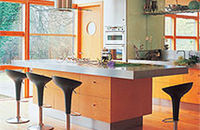
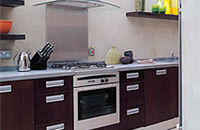
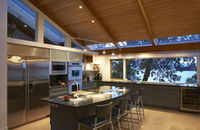
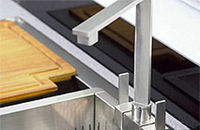
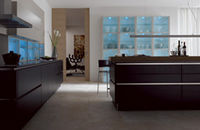
Factor in the cost of the kitchen design, units and materials, labour (installation, plumbing and electrics), appliances, wall and floor treatments, and try to include an extra 20% as a contingency amount. It's amazing how often the unexpected happens!
Will A New Kitchen Make My Home's Value Rise?
A renovated kitchen should increase the market value of your property by about 8% so, before you start, find out the value of your house to work out exactly how much you'll need to spend.
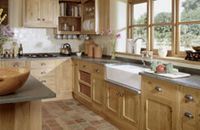
Keep thoughts of resale at the back of your mind, as anything too personal or cutting edge may deter future buyers. If you want to add your own bold, individual touches, use wall paint and accessories that are easy to change.
articles about Guide To Planning A Kitchen has finished in the study, we hope you feel satisfied with less of this article and give you infirasi in building your dream home, if you will forgive please share this link http://happyhourlosangeles.blogspot.com/2014/03/guide-to-planning-kitchen.html make it more useful for many people.
Guide To Planning A Kitchen
Guide To Planning A Kitchen
Picking the right units is a balance between what's going to work in your room, what captures the latest trend, what will appeal to future buyers and what you like.
1.Kitchen Layouts
The kitchen is the number one improvement that prospective buyers look for, so designing a perfect one is a must.
1.Kitchen Layouts
The kitchen is the number one improvement that prospective buyers look for, so designing a perfect one is a must.
Get The Layout Right
Start by assessing your own space, measuring up and making an accurate floor plan. The type of kitchen layout you choose will depend on the amount of space you have, but consider the following before you visit a kitchen planner.If you're ripping out existing units, you don't have to stick to the previous layout, although if it's a small space you may be stuck with making the most of what you've got.
Where Should You Start?
- Note the position of existing power points, pipes in and out, windows and doors.
- Using the same measurements, make a rough sketch of how you would like the appliances, worktops and doors to be, noting any changes in services that may be necessary.
- Bear in mind that changing the location of services or structural features will add to the overall cost.
- Play around with different combinations, until you have a design you're happy with that you can present to a kitchen planner.
As you go, think of a kitchen's functions and work these into zones in your plan. Food preparation, cooking, serving and washing-up afterwards are the four main jobs all kitchens need to fulfil. Make sure each zone has sufficient worktop space, storage for its associated stuff and all the necessary appliances to hand.
Designers also put great stock in the 'work triangle', which dictates the sink, cooker and fridge should form the corners of a triangle in relation to each other. Sinks traditionally live under the window because access to the plumbing is easier and having a wall cupboard above the sink results in banged heads - although it is possible to incorporate draining racks above it.
2.Kitchen Floorplans
If you go for a fitted kitchen and don't have strong feelings about the design and layout, our advice is to book appointments with three different kitchen companies to help you work out the floorplan accurately. Each appointment will take a couple of hours and you'll have to provide exact dimensions to get an accurate plan. Here's what to consider.

Creating A Floorplan
Once you have a handful of plans, go back to the company you were happiest with and ask them to incorporate any of the layout ideas you preferred that the other designers might have come up with. Don't be afraid to go back two or three times until you're 100% happy with your design - and don't be pressurised into extras you don't think will work for you.
What Are Your Layout Options?
A galley layout may be the only option in a very narrow kitchen, but having all the zones side by side is not hugely work-friendly. Storage is also a problem, with all those appliance taking up space. Generally you shouldn't fit anything other than base units to avoid it feeling claustrophobic, but there are exceptions: if your ceiling is high and the space opens out into a living area, floor-to-ceiling units will work.
3.Open-Plan & Small Kitchens
Open-plan kitchens are a major draw for potential buyers, the perfect party room and the place you'll spend all your time, day and evening - a kitchen-diner with space for slob-out sofas.

Planning Open-Plan Kitchens
'It is often more challenging to create a fabulous design in a large room than in a small one, especially with a modern kitchen,' says kitchen designer Mark Wilkinson (opens in a new window). Read on to find out how to get it right. How To Get It Right
- Using good details helps - for example paying attention to the right handles, or subtle details on the cabinetry.
- Another temptation in big kitchens is to space everything out, but - while it sounds trivial - you'll end up doing a lot more walking while you're cooking.
- It also increases the likelihood that through traffic will be milling around the work triangle, which is dangerous and should be avoided if possible. If you do have the space, site the fridge near the door so that family members can grab what they need without disturbing the cook.
- Contemporary kitchen buyers find unusual shapes, in units and islands, irrestistible. In an open-plan area such as this, a large island makes great use of the space, providing extra storage and a handy seating area.
- Knocking-through to create an open-plan space is a popular choice as it fits well with our modern lifestyle, and gives the scope to make a dramatic room.
- 'Buyers are asking for special shapes, for both units and islands,' says Mark Wilkinson. 'Integrated and separate tables that co-ordinate with the scheme are also in demand - in fact, the traditional breakfast bar has become rather passé.'

Planning A Small Kitchen
Small spaces have challenges all of their own. Ask yourself, is it possible to re-site anything - can the laundry appliances go in the garage, or is there room for a larder elsewhere? Think about extending wall units - go for a pale finish - all the way to the ceiling, storing lesser-used items in the uppermost cupboards.
Small spaces have challenges all of their own. Ask yourself, is it possible to re-site anything - can the laundry appliances go in the garage, or is there room for a larder elsewhere? Think about extending wall units - go for a pale finish - all the way to the ceiling, storing lesser-used items in the uppermost cupboards.
Space can also be saved with narrow appliances - most of the major manufacturers have a slim-line range. Use plenty of lighting, for example under the wall units or recessed into glazed cupboards, and keep pattern to a minimum. Integrated appliances also streamline the space, as their matching doors create a seamless end result.
4.Saving Money & Budgeting

Budgeting Your New Kitchen
What Costs Should You Include?Factor in the cost of the kitchen design, units and materials, labour (installation, plumbing and electrics), appliances, wall and floor treatments, and try to include an extra 20% as a contingency amount. It's amazing how often the unexpected happens!
Will A New Kitchen Make My Home's Value Rise?
A renovated kitchen should increase the market value of your property by about 8% so, before you start, find out the value of your house to work out exactly how much you'll need to spend.
How Can I Save Money?
Clearly, buying an off-the-peg kitchen from somewhere like Ikea will work out cheaper than going for a made-to-measure one. The differential in price is reflected in what you end up with - the latter will have cabinetry built from solid wood in situ, whereas standard kitchens are prefabricated offsite and assembled. What you choose isn't just down to your budget - there's no point in spending too much in a tiny house that in itself isn't worth much.Finding Installers
Choose your tradesman carefully - you can't hope to get the kitchen of your dreams if you employ an untested odd-job man to do it for you. Several kitchen companies provide their own installers, so you should be able to trust them for a good end result. If you have to source your own tradesman, speak to his previous clients to see if he came in on budget, if his attitude was good and if the work was up to scratch.Questions To Resolve Before You Buy
Before spending thousands on new units and appliances, ask yourself the following questions:- Do you want a mixture of wall and floor cupboards?
- Do you want freestanding or fitted units?
- What is your budget - off-the-peg or a bespoke design?
- Do you want a stand-alone cooker (such as a range) or a separate hob and oven?
- Do you want to keep the washing machine and tumble dryer in the kitchen, or can you put them in a dedicated laundry room?
- Do you want to put the dishwasher in the utility room? Will this involve a lot of carrying back and forth with heavy crockery?
- Is there space for a breakfast area to streamline the morning rush? Remember to include enough storage for mugs, tea and coffee tins and power points for the toaster and kettle.
- Will an extractor hood above the hob be sufficient, or do you need a separate system to air the room? Open-plan kitchens often need plenty of air extraction to keep adjoining spaces pleasant. Westin (opens in a new window) offers tailored solutions.
- Is there adequate storage for all your kitchen equipment on your plan? Are there enough worktops for food preparation?
- Where are you going to plug in and use permanent items, such as the kettle and toaster, and temporary ones, such as the food processor or juicer?
- Will you need a radiator, especially if you have included a seating area? Can you create a feature from it by using an unusual design?
- Do you want to dedicate an area at the kitchen table to doing or storing paperwork, such as bills? A kitchen designer can incorporate a small workstation to free up space elsewhere in the house.
- Do you want display storage for certain items - for example bottles and recipe books - or do you prefer to keep them hidden in a cupboard?
5.Choosing The Look
Picking the right units is a balance between what's going to work in your room, what captures the latest trend, what will appeal to future buyers and what you like.

Choosing The Look
When Will You Be Selling Up?Keep thoughts of resale at the back of your mind, as anything too personal or cutting edge may deter future buyers. If you want to add your own bold, individual touches, use wall paint and accessories that are easy to change.
Give It A Bespoke Look
'Individuality has been the clearest trend over the past few years,' says Mark Wilkinson. 'Rather than a specific colour, a mixture of colours that makes a scheme unique to the homeowner is prevalent. Also, it's popular to use different paint colours on the same kitchen, with a focus piece in maple or walnut.'
Choose The Right Finish
Using darker floor cupboards and paler doors for wall units will help open out a room and add contemporary detail. Dark wood is great for creating maximum impact in large rooms or knocked-through spaces. Gloss finishes are all the rage too, and reflective surfaces are great for maximising the light, but children's sticky finger marks can be a problem.
Consider Colour
Coloured units are readily available - high street suppliers offer a limited range of colours, so if you have a very specific shade in mind, try a supplier such as Miele (opens in a new window), which has literally hundreds to choose from. When it comes to construction materials, coloured and high-gloss options tend to be laminated board or MDF, while the wood options will either be veneered or solid wood.
Be Contemporary
articles about Guide To Planning A Kitchen has finished in the study, we hope you feel satisfied with less of this article and give you infirasi in building your dream home, if you will forgive please share this link http://happyhourlosangeles.blogspot.com/2014/03/guide-to-planning-kitchen.html make it more useful for many people.

